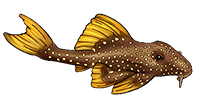Thanks.
If I can make a prediction, I think they are all going to end up being the calico orange color - I know calico-colored "common BNs" are readily available, but I've never heard of a calico BN with a head and tentacle phenotype like those of
A. sp. Rio Ucayali and
A. hoplogenys. Neither have I heard of a BN starting out with a "wild-type" color pattern and then changing to calico. The closest thing I can envision is how species like
and
change from dark to yellow as they age. (and sometimes they go back to their dark color... if it's the same phenomenon, will mine? Who can tell!

)
Although the LFS recalls they are wild caught, at the same time, they are not sure of the ID when purchased. And now they aren't even positive about which wholesaler they came from - possibly Ruinemans Florida; with that realization, the LFS is no longer certain about them being WC.
Currently, it is just my hypothesis that these are transforming colors from a
A. sp. Rio Ucayali or
A. hoplogenys pattern to the orange calico. My idea is based on two observations:
- The color diversity in the tank, and how it segregates by size. All of the smaller fish are the dark blackish-brown color with pinpoint iridescent spots and red edges/stripes on fins. The intermediate sized fish have less black, more red, and larger iridescent patches. In the largest fish, there's almost no black, except in tiny condensed spots; and the iridescent spots are still slightly distinguishable, but they have blended in with the orange to create the odd color pattern. If these color patterns were not a progression, I wouldn't expect them to assort so perfectly with size, but rather be randomly present in fish of different sizes (some orange small fish and some black big fish).
- When the fish first arrived in the LFS (a month or two ago is the first time I saw them), all of the fish were small and all of the fish were the blackish-brown color with red-edged fins and fine iridescent spots. That means the orange and intermediate colors have developed since the fish arrived, and it means the fish that are currently orange used to be the blackish-brown color.
I'm not surprised by the possibility that there could be calico mutants in any species strain. What surprises me, if my hypothesis about color change is correct, is that these fish would progress through what looks like an otherwise "normal" color pattern as seen in
A. sp. Rio Ucayali and
A. hoplogenys (and a few others, see this
COTM), instead of being born with an immature calico color pattern that just matures as the fish grows.
As you observed, only time will tell. Not only do I want to see how these grow out, but I also hope that they will breed for me so that I can witness the re-occurrence of the color transformation from start to finish.
Cheers, Eric








